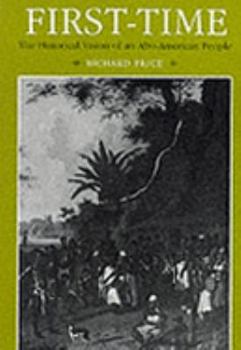First-Time: The Historical Vision of an Afro-American People
Select Format
Select Condition 
Book Overview
A classic of historical anthropology, First-Time traces the shape of historical thought among peoples who had previously been denied any history at all. The top half of each page presents a direct... This description may be from another edition of this product.
Format:Paperback
Language:English
ISBN:0801829852
ISBN13:9780801829857
Release Date:October 1983
Publisher:Johns Hopkins University Press
Length:208 Pages
Weight:1.00 lbs.
Dimensions:0.6" x 6.9" x 10.0"
Customer Reviews
2 ratings
Triumphant Slave revolts. That led to authonomy in 1776
Published by Thriftbooks.com User , 21 years ago
This is a must read for all in the black diaspora. Read how slaves organized revolted and gained authonomy. free from slavery in the 18th century. You will also find how they maintained their culture vitually unchanged in 2002! It is an amazing book with deep insight into this proud maroon culture in South America, Surinam. They trace their roots all the way back specific villages in Africa!
History at its Finest
Published by Thriftbooks.com User , 25 years ago
The Americas in colonial times were a setting for some of the most fascinating events and developments in all of history. The meeting of two worlds created sparks and waves unlike those produced by any other historical event. Because of its monumental importance and its unique nature, the area has attracted hordes of authors.However, in writing about topics in colonial American history, one must heed the ever-present danger of Euro-centricity. Most of the non-Europeans who took part in the creation of colonial societies (e.g. Africans and Native Americans) are all too silent in the available sources. Because of this, many scholars tend to rely too heavily on European perspectives. On the other hand, some have adopted the opposite extreme and have relied almost solely on non-European accounts when available. Richard Price, in examining the early history of the Saramaka maroons of Suriname with his 1983 work First-Time: The Historical Vision of an Afro-American People, is fortunately able to find the mean between these extremes. The strength of Price's book lies in its respect for non-European views, its impartiality, and its truth-seeking. Price makes explicit the extant importance of the Saramaka's oral history, not only the history itself, but also the manner in which the Saramaka preserve it. However, while he uses the Saramaka versions of events as a framework, Price is always sure to corroborate these accounts with "documentary" or "archival" evidence, and when he is unable to do so, he candidly alerts the reader. Price has a hunger for the truth. He often researches the most subtle details of Saramaka stories in order to provide the reader with a fuller story. These details are often also linked by Price to historical realities and conditions that are easily overlooked in a reading of the Saramaka accounts. Finally, I was impressed by the structure of the book- each page divided into two halves: the top sections containing a piece of Saramaka oral history, the bottom halves analyzing and critiquing these accounts using all other available sources and discussing their importance in Saramaka history and to the Saramaka people despite their flaws and inaccuracies.Overall, Price's work is a valuable asset to the collective history of colonial America, and a seeming treasure for the Saramaka people today.




